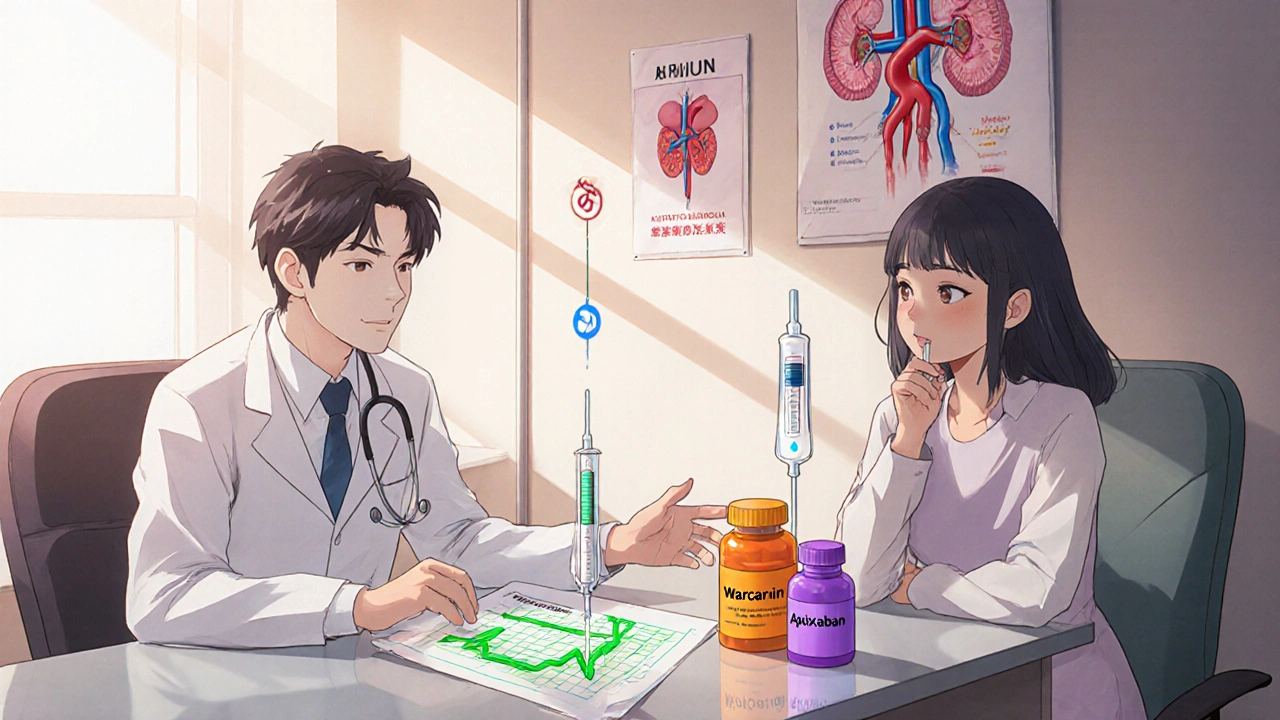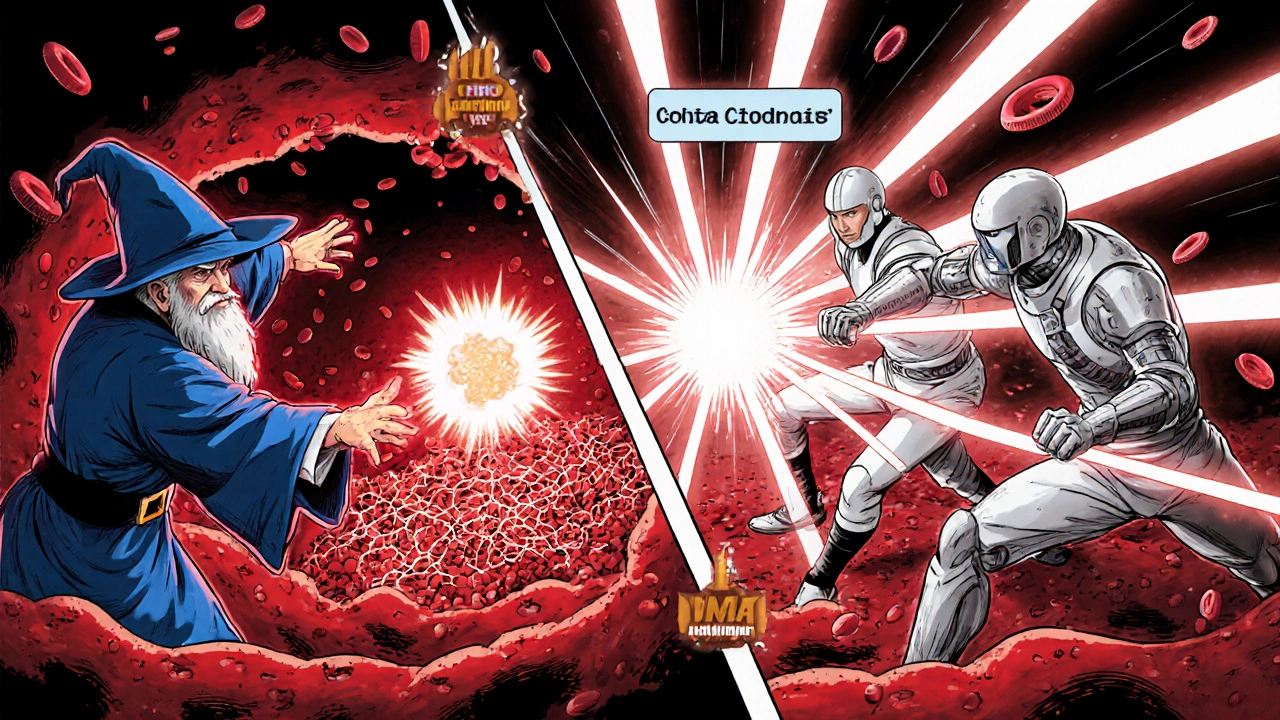Anticoagulant Bleeding Risk Calculator
Understand Your Bleeding Risk
This tool estimates your relative bleeding risk based on key factors. Results are for informational purposes only and should not replace medical advice.
Quick Takeaways
- Anticoagulant medications interrupt the clotting cascade to keep blood flowing smoothly.
- Warfarin, heparin, and direct oral anticoagulants (DOACs) are the three main families.
- Monitoring varies: INR for warfarin, occasional labs for DOACs, and activated clotting time for IV heparin.
- Bleeding risk is the biggest trade‑off; patient factors like kidney function and age matter.
- Lifestyle tweaks (diet, activity, medication timing) boost safety and effectiveness.
When doctors talk about anticoagulant medications are drugs that reduce the blood’s ability to form clots by targeting various steps in the clotting cascade. The goal is simple: keep blood moving where it needs to go while stopping it from forming dangerous plugs that can block veins or arteries. This article unpacks how these medicines work, the major families you’ll hear about, when they’re prescribed, and how patients can stay safe while on therapy.
Why Blood Clots Matter
Blood clots-technically called thromboses-can appear in veins (deep‑vein thrombosis, DVT) or arteries (stroke, heart attack). A clot that breaks free and travels to the lungs becomes a pulmonary embolism (PE), a life‑threatening emergency. According to the American Heart Association, DVT and PE together affect about 1 in 1,000 people annually in the United States. The underlying process involves platelets sticking together and a cascade of clotting proteins (factors) that turn liquid fibrinogen into a solid fibrin mesh. While clotting is essential to stop bleeding after injury, an overactive system can seal off vessels even when no wound exists.
How Anticoagulants Interrupt the Clotting Cascade
The clotting cascade consists of two pathways-intrinsic and extrinsic-that converge on factor Xa, which then converts prothrombin (factor II) to thrombin. Thrombin finally changes fibrinogen into fibrin, forming the mesh that traps cells and platelets.
Anticoagulant drugs target one or more of these steps:
- Vitamin K antagonists (e.g., warfarin) block the liver’s ability to recycle vitamin K, a cofactor needed to make clotting factors II, VII, IX, and X.
- Heparins (unfractionated and low‑molecular‑weight) bind to antithrombin III, boosting its ability to inactivate thrombin (IIa) and factor Xa.
- Direct oral anticoagulants (DOACs) either inhibit factor Xa directly (apixaban, rivaroxaban, edoxaban) or block thrombin itself (dabigatran).
By weakening these key proteins, the drugs keep the fibrin net from forming or make it dissolve faster, reducing the chance of a clot growing large enough to cause trouble.
Main Families of Anticoagulants
| Type | Mechanism | Typical Dosing | Monitoring | Pros | Cons |
|---|---|---|---|---|---|
| Warfarin (Vitamin K antagonist) | Blocks synthesis of clotting factors II, VII, IX, X | 5‑10 mg orally once daily (dose adjusted) | INR 2‑3 (target range) | Cheap, long track record, reversible with vitamin K | Dietary restrictions, frequent INR checks, many drug interactions |
| Heparin (unfractionated) | Enhances antithrombin III to inhibit IIa & Xa | IV infusion, dose based on weight | Activated clotting time (ACT) 150‑200 seconds | Rapid onset/offset, useful in hospitals | IV line required, risk of heparin‑induced thrombocytopenia (HIT) |
| Low‑Molecular‑Weight Heparin (e.g., enoxaparin) | Preferentially blocks factor Xa via antithrombin III | Subcutaneous injection, fixed dose | Usually no routine labs; anti‑Xa level in special cases | Predictable, once‑ or twice‑daily dosing | Injection site pain, not easily reversible |
| DOACs - Factor Xa inhibitors (apixaban, rivaroxaban) | Directly inhibit factor Xa | Oral, 2‑3 times daily (apixaban) or once daily (rivaroxaban) | No routine monitoring needed | Fixed dosing, fewer food/drug interactions | Costlier, caution in severe kidney disease |
| DOAC - Direct thrombin inhibitor (dabigatran) | Blocks thrombin (IIa) activity | Oral, 2 times daily | No routine labs; dilute thrombin time if needed | Effective for stroke prevention in AFib | Gastro‑intestinal upset, requires a specific reversal agent (idarucizumab) |

When Doctors Choose an Anticoagulant
Prescribing decisions hinge on the clinical scenario and patient characteristics. Here are common indications:
- Atrial fibrillation (AFib) - reduces stroke risk; DOACs dominate because of ease of use.
- Deep‑vein thrombosis or pulmonary embolism - initial treatment often starts with heparin (IV or LMWH) then transitions to a oral agent.
- Mechanical heart valves - warfarin remains the only approved oral option.
- Post‑operative thromboprophylaxis - LMWH or low‑dose DOACs for hip/knee replacement patients.
Kidney function is a key filter. DOACs are partially cleared by kidneys; patients with creatinine clearance <30 mL/min often need dose reduction or a switch to warfarin. Liver disease, extreme body weight, and concurrent medications (e.g., certain antibiotics, antifungals) also tilt the balance.
Managing Bleeding Risk
All anticoagulants increase the chance of bleeding, from minor bruises to serious intracranial hemorrhage. Strategies to stay safe include:
- Regular lab checks where required-INR for warfarin, anti‑Xa for LMWH in renal failure.
- Assessing fall risk in older adults; a history of falls may favor a lower‑dose regimen or a short‑acting agent like heparin.
- Reviewing over‑the‑counter meds such as NSAIDs or high‑dose aspirin, which amplify bleeding.
- Educating patients on signs of serious bleed (e.g., persistent nosebleeds, blood in urine, severe headache).
- Having reversal agents ready-vitamin K for warfarin, idarucizumab for dabigatran, andexanet alfa for factor Xa inhibitors when available.
In emergency surgery, stopping an anticoagulant for a few hours (or using a reversal agent) can prevent catastrophic bleed while still protecting against clot re‑formation.
Lifestyle Tips for Patients on Anticoagulants
Medication adherence is only part of the puzzle. Everyday habits make a big difference:
- Consistent food intake-especially for warfarin, keep vitamin K intake (leafy greens) steady day‑to‑day.
- Hydration-helps kidneys clear DOACs and reduces risk of kidney stones that could affect dosing.
- Avoiding high‑impact sports if you have a high bleed risk; low‑impact activities like walking or swimming keep circulation moving without bruising.
- Medication timing-take oral agents at the same time each day, preferably with food if the label suggests.
- Travel planning-carry a copy of your prescription and a list of your anticoagulant, especially for international flights where medical records may not follow.

Common Myths About Blood Thinners
Myth #1: "If I’m on a blood thinner I can’t eat vegetables." Wrong. Leafy greens contain vitamin K, which affects warfarin, but you don’t have to avoid them-just keep your intake consistent.
Myth #2: "All blood thinners are the same." Not true. Heparin works in minutes via IV, while DOACs take hours orally and have different reversal options.
Myth #3: "If I miss a dose, I’m doomed to clot.” Missing a single dose of most DOACs may raise risk slightly, but it isn’t an emergency-just take it as soon as you remember, unless it’s almost time for the next dose.
Frequently Asked Questions
What is the difference between a blood thinner and an anticoagulant?
People often use the terms interchangeably. Technically, "blood thinner" is a lay term that includes both anticoagulants (which target clotting factors) and antiplatelet drugs (which stop platelets from sticking together). The article focuses on anticoagulants.
How long does it take for warfarin to start working?
Warfarin takes about 48‑72 hours to reach full effect because it must deplete existing clotting factors. That’s why doctors often bridge with heparin during the startup phase.
Can I switch from warfarin to a DOAC?
Yes, many patients transition after stabilizing their INR. The switch usually involves stopping warfarin when the INR falls below 2.0 and starting the DOAC the same day. Your doctor will test kidney function first.
What should I do if I notice unusual bruising?
Contact your healthcare provider right away. They may adjust the dose, order blood tests, or prescribe a reversal agent if bleeding is severe.
Are there natural alternatives to prescription anticoagulants?
Some foods (e.g., garlic, ginger, omega‑3 fish oils) have mild antiplatelet effects, but they cannot replace prescription drugs for high‑risk conditions. Always discuss supplements with your doctor.
Bottom Line
Anticoagulant medications are a cornerstone of modern preventive cardiology and vascular health. By understanding how each class works, when it’s prescribed, and how to manage bleeding risk, patients can stay active and safe. Talk to your clinician about the best option for your situation, keep up with monitoring, and adopt the lifestyle tweaks outlined here. The right balance between clot prevention and bleeding control can make a huge difference in quality of life.


8 Responses
Greetings dear readers The marvel of anticoagulant pharmacology never ceases to inspire a vibrant curiosity The mechanisms described here strike a perfect chord between biochemical precision and clinical artistry By targeting vitamin K pathways or factor Xa the therapies weave a protective tapestry for our circulatory highways Let us celebrate the progress while staying vigilant of bleeding hazards Together we can navigate safer therapeutic journeys
These blood thinners are not just medicines they are tools of a hidden agenda The pharma giants push them to keep patients dependent on costly prescriptions The side‑effects are downplayed while the risks are magnified in secret studies The public deserves transparency about how these drugs are engineered and monitored
India’s own research should lead the world in creating affordable anticoagulants rather than relying on foreign patents
Understanding how to monitor anticoagulants can prevent dangerous complications. For warfarin the key test is the INR and it should stay within the therapeutic range. Patients often need to have the INR checked weekly at the start of therapy. Once stable the frequency can be reduced to monthly visits. Diet plays a role because vitamin K rich foods can shift INR values. Leafy greens such as kale and spinach contain high vitamin K. If you enjoy these foods you may need to keep your intake consistent. Sudden changes in vitamin K consumption can cause the blood to clot too much or bleed. DOACs such as apixaban and rivaroxaban do not require routine INR monitoring. However kidney function must be assessed before prescribing a DOAC. Creatinine clearance below 30 ml/min often calls for dose adjustment or an alternative. For patients on heparin an activated clotting time is used in the hospital. The target range is usually 150 to 200 seconds. Heparin‑induced thrombocytopenia is a rare but serious immune reaction. If platelet counts drop dramatically you should alert your provider immediately. Lifestyle factors such as alcohol use and missed doses also affect safety. Setting a daily reminder can help maintain consistent medication timing. Always keep a list of other drugs and supplements you take to avoid interactions. Discuss any bleeding symptoms with your doctor without delay.
Got a quick tip for anyone on warfarin – keep a food diary for the first month It’s amazing how a single serving of broccoli can swing your INR a notch or two Consistency is king so try to eat similar portions each day Also, set a phone alarm for your dose; I’ve missed fewer pills since I started that simple habit Finally, pack a small medical alert card in your wallet just in case
Therapeutic drug monitoring (TDM) of vitamin K antagonists remains indispensable; INR targets of 2.0–3.0 mitigate thromboembolic risk while minimizing hemorrhagic events. Pharmacokinetic variability necessitates dose titration algorithms integrating hepatic function indices. Adjunctive nutraceutical intake must be logged to preclude confounding variables in anticoagulation management.
It is regrettable that the prevailing narrative glorifies anticoagulants without adequately addressing their iatrogenic potential. The literature frequently underrepresents fatal hemorrhage events, thereby skewing risk‑benefit assessments. One must scrutinize the industry‑driven propensity to favor newer agents despite equivocal superiority over established therapies. A sober re‑evaluation of dosage guidelines is therefore warranted.
In the grand tapestry of medical practice, each intervention is a thread woven with intention and consequence. Anticoagulants exemplify this duality, offering salvation from clots while courting the specter of bleeding. Reflecting on such paradoxes invites clinicians to balance empirical evidence with humane judgment. Ultimately, the art lies in honoring both the science and the lived experience of patients.